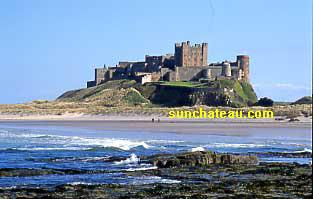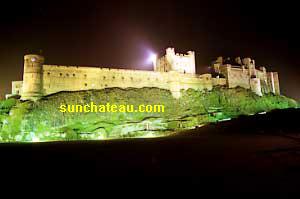|
班博城堡(Bamburgh
Castle)建于公元五四七年,在十一世纪原是诺桑柏兰伯爵罗伯特所有,威廉二世攻下城堡后,产权收归皇家,从此开始扩建这座城堡,亨利二世时将城墙建筑完毕。这里气候宜人,气温常年在0-25摄氏度之间。这座屹立在英格兰东北岸临北海边的大城堡,完整得令人印象深刻,最后一任堡主阿姆斯特朗勋爵(Lord
Armstrong)的后代到现在都还住在城堡内。
以下是班堡城堡英文版的简要历史,我看着很吃力,更不用说翻译了。如果哪位读者愿意为大家翻译该文,请到茗香茶楼说明,谢谢了!
A Short History of Bamburgh Castle.
Most guide books and some history books will tell you that the story of Bamburgh
began in the year AD 547—more of that presently. Try to imagine the sixth
century. This is not easy, as this was a dark, dangerous and violent time.
Remember that the Romans left this country a couple of hundred years previously,
leaving the native Britons to defend themselves. Already, at this time, enemies
from abroad were struggling to gain power in the South Eastern part of the
country. These barbarians came from north Germany and Denmark. They were called
Saxons and Angles, and, if you are English, whether you like it or not, they
were most likely your ancestors. However, if you are of Celtic descent, the
chances are that you are not of the blood of the Saxons. Celts occupied most of
the West Country and all of Wales, which was a thorn in the side of the
Anglo-Saxon.
King Ida, “The Flamebearer”
Finally, in the year AD 547, King Ida, or to give him his full title,“The
Flamebearer,” landed his expeditionary force at Flamborough Head and conquered
Northumberland. At this time, Northumberland stretched from the Humber to The
Firth of Forth. This was a large kingdom and the capital was Bamburgh. King
Ida's grandson, Ethelfrith, gave the settlement to his wife, Bebba, and it was
then named Bebbanburgh, in her honour, ending up with the name it bears today.
In the sixth century Bamburgh Castle looked nothing at all as it appears today.
That ancient, revered historian The Reverend Bede first described Bamburgh as
being fortified by a hedge and then by a timber palisade. It was not until the
Norman Conquest that the castle as we now know it began to take shape. The
Normans were the finest builders of fortifications in the Western world and they
made a formidable castle at Bamburgh, which stood until the end of the Wars of
the Roses. Until that time, the castle had been besieged on numerous occasions,
but was never taken. The invention of cannon spelt disaster for all castles,
and, for the most part, they were either abandoned or left to fall into
disrepair. This is what happened to Bamburgh.
The Forster Family.
Until the Wars of the Roses (1453—1486) the castle and lands adjacent had been
the property of the Crown. During the latter part of the reign of Elizabeth 1st
she decided to give the castle and lands to the Forster family - in particular
one Claudius Forster. This worthy gentleman had been a Warden of the Middle
March for quite a number of years and, for services rendered, was presented with
this not inconsiderable reward. To explain “Marches” one must try to visualise
the Scottish Border country. There are three ways into and out of Scotland. They
are by way of the East, West and Middle Marches. Riever country! They were
lawless bands of cattle thieves and thieves of anything else for that matter.
With Claudius they had almost met their match. He was as much of a rogue or
maybe more so than the rievers on either side of the border. Now Claudius was
firmly seated in what was left of Bamburgh Castle namely the Keep with walls
between 9 and 12 feet thick. He lived until he was 101 years old (which would
have made him about 12 years old at the time of Flodden!) He sired 11 sons and 2
daughters. None of them could match their father, in any respect. One of the
most famous, or infamous, depending on your viewpoint, must be Tom Forster. It
was he and a handful of his followers who took part in the first Jacobite
rebellion in 1715. Tom was a trifle short of cash at the time, and, with a view
to the main chance, joined the side of the Jacobites. The rebels, thinking they
had recruited a man of some substance, promptly promoted him to General. Tom was
delighted and rode off to battle to face the soldiers of the King. Arriving at
the battlefield he cast his eyes upon the opposition and promptly surrendered.
He was transported to Newgate prison and locked up. Back at Bamburgh Castle was
Tom's sister, Dorothy. A gem! Having heard of the predicament that Tom had
placed himself, she and her maid set off, on horseback, to visit her brother.
She visited him on several occasions, but on the final visit she saw him in his
cell, alone and not with her maid who had accompanied her on the previous times.
Dorothy wore her maid's clothes under her own, and, at the right time, dressed
Tom in the maid's clothes. The guards by this time had changed and were quite
accustomed to seeing two ladies leaving the cell containing General Tom, little
knowing that the General was now a lady's maid! All three rode back to Bamburgh
Castle where Dorothy hid Tom for two years. He eventually escaped to France by
taking a ship from the mouth of the Waren bum, close to Bamburgh. Portraits of
the brother and sister still hang in the castle, along with a dress worn by
Dorothy along with a pair of her tiny shoes.
Lord Crewe.
The Forster family was now bankrupt, and in the middle of the eighteenth century
sold the castle and lands. Lord Crewe, Bishop of Durham, ably assisted by Doctor
Sharp, purchased the property. This worthy gentleman built a windmill at the
north end of the castle, which ground corn, and this was distributed to the
poor. Amongst other good deeds was his setting up of a schoolroom in the castle
educating young girls for domestic service. He also set up a system of signals
between the Castle and Holy Island for the protection of seafarers on this
particularly hazardous stretch of coast. On stormy days men on horseback
patrolled the beach. A lot of money could be made from salvage! There are still
reminders of this at the castle in the shape of massive iron chains, each link
of which weighs about 100 pounds. These chains were wrapped around a beached
ship and then pulled up onto the hard, out of harms way. Teams of Shire horses
carried out this heavy work.
Lord Armstrong.
After the end of the regime of Lord Crewe, the castle was bought and splendidly
restored by the 1st Lord Armstrong at the latter part of the 19th Century. The
cost of the restoration at this time was a staggering one million pounds. The
castle remains in the ownership of the Armstrong family.
Archaeology.
In the early 1970's, an archaeological excavation was carried out at the north
end of the castle grounds. A Dr. Hope-Taylor oversaw this. At this "dig" he made
what he described as "the most important discovery of my career". It was
accurately estimated at the scene of the dig that to remove and sift through one
foot of soil was to go back 200 years. On this dig and their journey back
through time, they came across many interesting finds, but none more important
nor significant than a tiny piece of beautifully worked gold. It was about the
size of a thumbnail and it dated back to the early seventh century, predating
the Lindisfarne Gospels by 100 years. It was shaped like an intertwining beast
and was affectionately named "The Bamburgh Beast". The monks on Lindisfarne must
have seen and examined this article of beauty, and, in all probability, copied
it into some of the beautiful illuminations portrayed in their Gospels. The dig
carried on to a depth of eight feet, spanning a period of 1,600 years and still
they found signs of human habitation - fish bones, carbonised cereals of grain,
etc. Therefore it has been proved conclusively that Bamburgh was a settlement
long before the arrival of the Anglo Saxons and probably before the Romans. More
recently - in fact - in 1998, a team from Durham University explored the
interior of the Castle grounds with ultrasonic scanning equipment. This
sophisticated mechanism could detect man-made structures many metres under the
ground. What they discovered was evidence of fortifications predating the Roman
Conquest.
资料馆 |